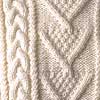| This Week’s Topic… | |||

Best viewed in
|
Aran Sweaters The
Aran Sweater takes its name from the set of islands where it originated
many generations ago, off the West coast of Ireland. The Aran Islands
lie at the mouth of Galway Bay, at the mercy of the relentless Atlantic
Sea. The Islanders were fishermen and farmers whose lives and
livelihoods were deeply intertwined. The Aran Sweater was born of this
environment, passed down from generation to generation, and has since
become the ultimate symbol of Irish Clan heritage.
The sweater has many attributes which made it suitable clothing for the island's community of fishermen and farmers. It is water repellent, not allowing the rain to penetrate the sweater thus keeping the wearer dry. An Aran sweater can absorb 30% of its weight in water before feeling wet. The natural wool fibre used in the sweaters is breathable, drawing water vapour away from the skin and releasing it into the air, thus helping the body to maintain an ideal temperature. Most importantly, of course, the sweater kept the wearer warm on the cold days and nights at sea or on the farm. Wool has an excellent insulating capacity due to the high volume of air in it, and this helps protect the wearer from excessive cold and heat. As a craft, the Aran Sweater continues to fascinate audiences around the world. A finished sweater contains approximately 100,000 carefully constructed stitches, and can take the knitter up to sixty days to complete. It can contain any combination of stitches, depending on the particular clan pattern being followed. Many of the stitches used in the Aran Sweater are reflective of Celtic Art, and comparisons have been drawn between the stitches and patterns found at Neolithic burial sites such as Newgrange in Co. Meath.
|
||


